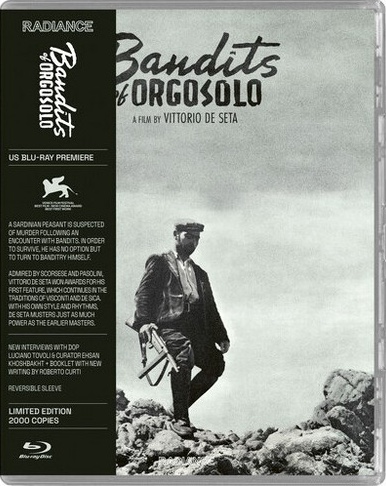Michele and his little brother Peppeddu are Sardinian shepherds who manage to just barely scape by in their quiet and dignified life. Their lives are shattered when three bandits rustling pigs cross paths with them. When Michele is forced to give refuge to the bandits on the run from the law, he is mistakenly accused of murder and banditry himself and is forced to flee his land with his son and sheep into rough and desolate outer lands. With harsh weather conditions and a lack of food and water for his herd, the sheep begin to die off, robbing him of everything he has built his life on. What depths is Michele willing to stoop to due to this unfortunate series of circumstances?
Bandits of Orgosolo is a tragic piece of classic Italian neo-realist cinema. By showing how the circle of crime and violence never stops, it reflects a kind of hopeless fatalism where a good man can sacrifice all his convictions if pushed far enough. The film opens with a voiceover describing the life of the Sardinian shepherd with a feel almost like a documentary, but then as the narrative unfolds, we see a man borne forth on uncontrollable currents that sweep him into a maelstrom of futility. Using a cast made up entirely of non-professional actors, the film feels all the more real in its portrayal of a remote and little known culture. Michele Cossu has a resting look of despair about him. As we watch him in the early minutes of the film going about his day, mending a sheep’s leg and making cheese, we sense the impending doom that will settle into his bones. The way that Vittorio de Seta captures the Sardinian landscape and the people within it also reflects the spare and desolate nature of the film. Often the characters are shot as small specks in the distant background amid barren, rocky terrain. The scene of the dead sheep scattered amongst the rocks is a haunting one in particular. A few scenes are reminiscent of Antonioni’s wide angle shots where the landscape is treated more as the main character than the people wandering through it. But this is where the similarities end. De Seta doesn’t ever lose site of the story and of Michele’s eventual downfall and resignation to a violent circle, a whirlpool of regret.
Bandits of Orgosolo has been newly restored in 4K from the original camera negative by The Film Foundation and Cineteca di Bologna, and the results are great. This film has some great cinematography of spare landscapes, and the transfer captures it wonderfully with a very clean, well-balanced look. The audio track provided is a basic Italian mono track and captures the spare dialogue adequately. It’s pretty much the opposite of a showy audio track, but it gets the job done. Radiance has provided a few nice extras that give additional context around the film. Included is an interview with cinematographer Luciano Tovoli and an interview with curator Ehsan Khoshbakht as well as a trailer for the film. We also get a nice physical booklet with a very good essay from Robert Curti about the film and De Seta and how they fit into the Italian neo-realist movement.
Bandits of Orgosolo is a lovely and heart-breaking film that captures a quiet desperation and inevitability extremely well. I’m so glad Radiance is unearthing hidden gems like this, so they will not be forgotten.

